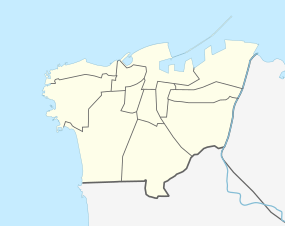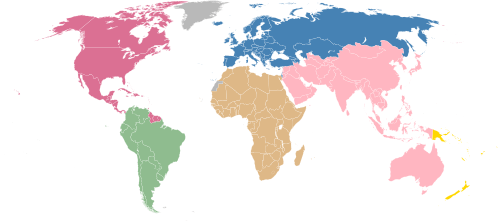Lebanese Premier League
.png) | |
| Country | Lebanon |
|---|---|
| Confederation | AFC |
| Founded | 1933 |
| Number of teams | 12 |
| Level on pyramid | 1 |
| Relegation to | Lebanese Second Division |
| Domestic cup(s) |
Lebanese Super Cup Lebanese Elite Cup |
| League cup(s) | Lebanese FA Cup |
| International cup(s) | AFC Cup |
| Current champions | Safa (2015–16) |
| Most championships | Al-Ansar (13 Titles) |
| TV partners |
Al Jadeed(live matches) Al-Manar & Television de Liban (highlights) |
| Website | lebanese-goal.com |
|
| |
The Lebanese Premier League (French: Championnat du Liban de Football; Arabic: الدوري اللبناني لكرة القدم) is the top division of the Lebanese Football Association league competitions. It was founded in 1900 and began in 1934 and their confederation is the AFC. There are 12 teams competing; the bottom two teams are relegated each season to the Lebanese Second Division, and are replaced by the top two teams in the second division who are promoted to the Premier League.
Seasons run from October to May. Most games are played on Saturdays and Sundays, with a few games played during weekdays. The most successful club in the history of the league is Al-Ansar, topping with 13 league titles while Al-Nejmeh and Homenetmen Beirut have 7 titles. Al-Ansar set a Guinness world record by winning 11 consecutive league titles between 1988 and 1999, a record that has since been surpassed by Skonto FC from Latvia.[1]
Overview
The Lebanese FA is composed of four divisions: the Lebanese Premier League (although it is rarely referred to with the First prefix), and, below that, the Lebanese Second Division, which has been the second tier of Lebanese football since 1934. Since 1950, the Lebanese Third Division in Lebanon is also a professional league, and the Lebanese Fourth Division is also founded in 1950. The Lebanese Premier League is based upon home and away fixtures. The points system is the international and most used system:
- Win: 3 points
- Draw: 1 point
- Loss: 0 points
- Entering Administration: 9 points deduction
Ranking structure
If teams are level on points, tie-breakers are applied in the following order:
- Goal difference for the entire season
- Total goals scored for the entire season
- Head-to-head results (total points)
- Head-to-head goals scored
- Head-to-head away goals scored
- Total away goals scored for the entire season
Media coverage
The Lebanese League broadcasting rights are distributed to Al Jadeed and Al-Manar TV. Live coverage of each game is broadcast 4 times a week, and weekly highlights of each match are produced once a week.
- Al Jadeed (Domestic Broadcasting) Official Television Station "http://www.aljadeed.tv/LebaneseLeague.html?LeagueId=14"
- Al-Manar (Domestic Broadcasting) Selected Matches
Lebanese Premier League clubs (2015-16)
| Club | Location | Stadium | Stadium capacity | Coach |
|---|---|---|---|---|
| Al Ahed | Beirut | Beirut Municipal Stadium | 22,500 | |
| Al Ansar | Beirut | Beirut Municipal Stadium | 22,500 | |
| Al Egtmaaey Tripoli | Tripoli | Tripoli Municipal Stadium | 22,000 | |
| Al Nejmeh | Beirut | Rafic El-Hariri Stadium | 5,000 | |
| Hekmeh (R) | Beirut | Bourj Hammoud Stadium | 8,000 | |
| Nabi Sheet | Baalbek | Nabi Shayth Stadium | 5,000 | |
| Racing Beirut | Beirut | Bourj Hammoud Stadium | 8,000 | |
| Safa | Beirut | Safa Stadium | 4,000 | |
| Salam Zgharta | Zgharta | Zgharta Stadium | 5,000 | |
| Shabab Al-Sahel | Beirut | Beirut Municipal Stadium | 22,500 | |
| Shabab Al-Ghazieh (R) | Saida | Saida International Stadium | 22,600 | |
| Tripoli SC | Tripoli | Tripoli Municipal Stadium | 22,000 | |
Previous winners
Champions
Topscorers
Lebanese diaspora players Elrich was given a contract by Nejmeh before he started his career in Australia By inviting new players from the other nations which had a large Lebanese community from the United States, Canada, Mexico, Argentina, Brazil, Germany, Colombia, Sweden, Norway, Australia, Ivory Coast, Egypt, France and others, they are hoping for a new beginning of Lebanon's football, since this was becoming popular in Lebanon. The appearance of so many Lebanese players in other countries; like Faryd Mondragon (Colombia), Miguel Layún and Miguel Sabah (Mexico); or legendary players and managers such as Pierre Issa (South Africa), Antonio Mohamed (Argentina) and Ahmad Elrich (Australia) are sending the inspiration to Lebanese people in football. See alsoReferences
External links |


